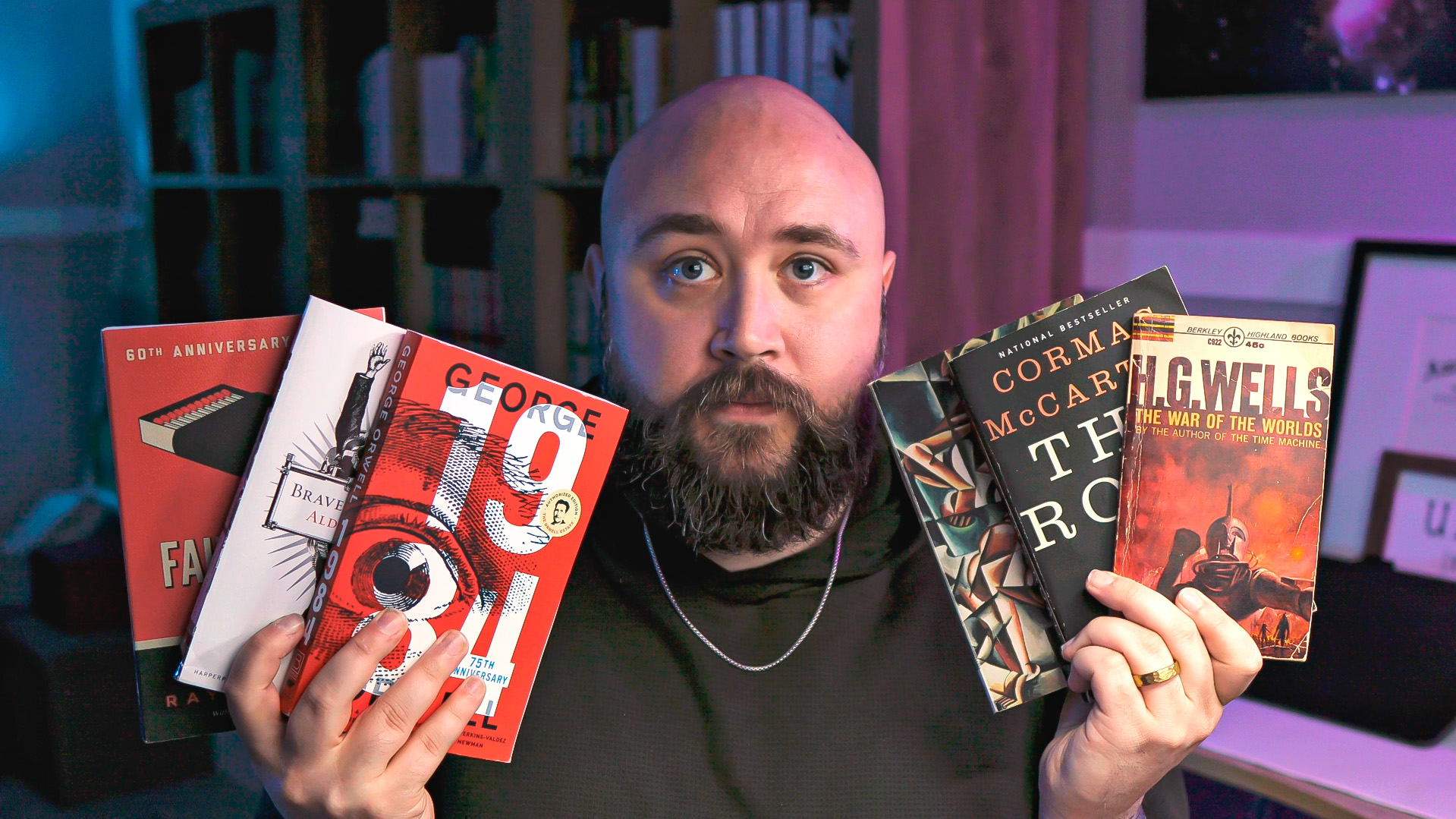Y’know, reading the Earthseed Saga really got me thinking. There’s this thing that happens when you walk into a bookstore or scroll through Goodreads, hoping to stumble upon something interesting or new, something you’ve either never heard of before or something you keep hearing about but haven’t picked up yet … and, almost invariably, you’re struck by the ubiquity of the dystopian and post-apocalyptic genres. It’s not subtle: completely overgrown ruins of cities; smoldering wastelands; authoritarian regimes with catchy slogans like Freedom is Slavery; climate-ravaged hellscapes; plucky, scrappy survivors decked out in scavenged gear. It’s everywhere, and it’s not just relegated to literature. There’s no shortage of it on TV and in film, in video games, in tabletop RPGs. You could say that these are the stories of our time. And, to be honest, they are. But what I want to explore here isn’t why they’re so popular as much as why we are drawn to them in the first place. Whether it’s Orwell or Atwood or Butler or Bradbury, why do we get all tingly inside at the thought of the world unraveling?
A Brief History of the End
Dystopias and post-apocalypses, as literary forms, are not exactly new, right? I mean, most of the time they feel modern, but the truth is, humanity has been fantasizing about the downfall of society for a long time. We could argue that this all began, really, with the last book of the Bible: Revelation. That book alone, with its harbinger horsemen, rivers of blood, and flaming trumpets of doom, may have set the standard for imagining the world at its darkest. Of course, in those earlier days, an apocalypse was seen as more of a religious purge, a sort of purifying catastrophe that cleansed the world of sin and evil, I mean, see the story of Noah and the flood all the way back in Genesis, the first book of the Bible, for another example of this.
Jump ahead a few thousand years, and we enter the Age of Enlightenment. Suddenly, the apocalypse wasn’t necessarily God smiting the wicked; it was us, humankind, bringing it all down upon ourselves. Cue Mary Shelley’s The Last Man in 1826, a novel that, by today’s standards, is kind of a proto-post-apocalyptic tale. It was here we see the roots of what would later become a common trope in science fiction: humans, with all their technological prowess, their dreams of control, fumbling the ball and making things irreversibly worse. Shelley’s novel was followed by more of these “dark future” stories as industrialization, war, and the swift rise of science began to spark not just hope for the future, but insufferable amounts of anxiety.
Fast forward to the 20th century, and we start to get some of the heavy hitters: E. M. Forster’s underrated The Machine Stops, Zamyatin’s influential We, Huxley’s Brave New World, Orwell’s 1984, Bradbury’s Fahrenheit 451. These works are all unmistakable in their pessimism about the human condition. They imagine futures where systems of control, dehumanization, the loss of individual agency, it’s all taken to terrifying extremes. And yet, despite their bleakness, we read them. We love them! And the trend continued into the post-apocalyptic, from H. G. Wells’s The War of the Worlds to Cormac McCarthy’s The Road. These stories strike us not only because they feel plausible, but because there’s something deeply human about wondering: What would we do if it all fell apart?
Catastrophizing as a Cultural Pastime
Which brings us to the question: Why? Why, when we sit down to read, do we so often reach for dystopias and apocalyptic tales? Shouldn’t we be leaning into, I don’t know, hopeful futures, given that life is stressful enough without imagining it all going up in flames? But here’s the thing. If we’re being honest, humans are pretty bad at imagining true utopias. They’re boring, they’re narratively dull because they lack conflict, and as readers, we thrive on conflict. When there’s nothing at stake, there’s no story.
In fact, there’s a reason why most literary utopias end up being thinly veiled dystopias. We can’t seem to accept that a perfect world, a world where everything runs smoothly, wouldn’t turn against us in some horrific way. It’s like we don’t trust perfection. We need to see it fall apart. There’s something cathartic in imagining political systems, technological systems, environmental systems … systems that are supposed to be too big to fail, failing spectacularly.
Part of it, of course, comes from that previously mentioned anxiety, right? Something that, arguably, we as a species have always had in spades, but made worse in the post-industrial age. If you chart the rise of dystopian and apocalyptic literature, you’ll notice that these stories tend to spike around times of unrest, be it cultural, political, or economic. Orwell, for instance, was deeply informed by the totalitarian regimes of the 20th century. Post-apocalyptic fiction found a resurgence after the two World Wars and the rise of nuclear tension. It’s no coincidence that these genres are flourishing now, in a time of climate crisis; of extreme political polarization; and rapid, seemingly uncontrollable technological growth.
Whether they’re about nuclear fallout or ecological collapse or technological enslavement, these stories are ways of processing our collective fears. When we read about these dark futures, there’s a part of our brain that’s trying to make sense of the chaos around us, trying to imagine what could happen, if only to prepare for the worst. But I think it’s not just about catharsis, right? There’s something more than just subconscious crisis management happening when we pick up these books.
A Complicated Kind of Hope
Oddly enough, as much as we love a good dystopia, I don’t think it’s the darkness that keeps us coming back, not really. It’s the hope that simmers beneath it all. Take Cormac McCarthy’s The Road, for example. On the surface, it’s about as bleak as fiction can get. A father and his son, wandering through a charred landscape, scavenging for food and fending off cannibals. But the core of the novel isn’t about the apocalypse—it’s about love, it’s about survival, it’s about the unbreakable bond between the two main characters. McCarthy’s world may be brutal, but there’s something transcendent in their struggle to survive.
Similarly, 1984, for all its bleakness, is not as nihilistic as it may appear. It’s a warning, sure, but it’s also a call to awareness, to resistance. Dystopias, in their most impactful moments, are acts of rebellion against complacency. They implore us to confront what we might become if we don’t push back against forces like authoritarianism, against environmental destruction, against the numbing effects of technology. The best dystopian works, the ones that stay with us, aren’t really about despair. They’re about the glimmer of hope that persists even in the darkest of times. They’re about the potential for change.
And this is, I think, one of the main reasons why we’re so drawn to these stories. Dystopias and post-apocalypses aren’t about the end of the world, they’re about what happens after. They’re about survival, they’re about people clawing their way through the ruins and, in many cases, trying to build something new. Even in the most pessimistic scenarios, there’s always this underlying question: What would you do? How would you fight? How would you survive? What kind of person would you become if the structures of civilization were stripped away?
The Human Condition in Extremis
In a way, these stories are about exploring the human condition in its most extreme form. When everything we rely on, our governments, our infrastructures, our technology, falls apart, what remains? Who are we, really, when the rules no longer apply? Science fiction, and particularly dystopian and post-apocalyptic fiction, allows us to test these boundaries without real-world consequences, thank God. We can explore these nightmarish futures from the safety of our reading chairs, knowing that we’ll emerge on the other side physically unscathed.
But it’s also about possibility. There’s an unspoken belief, I think, that we read these stories not just to indulge in the thrill of disaster, but because we are genuinely curious about what comes next. If the world as we know it ends, what new forms of society might emerge? How might we reinvent ourselves? These stories, as bleak as they can be, also remind us that the end of one world could mean the beginning of another.
Conclusion
So, why are we drawn to dark futures? I don’t think it’s because we’re nihilists or sadists or because we enjoy watching the world burn. I think it’s because these stories tap into something fundamental about the human experience. They allow us to confront our fears, to imagine the worst-case scenario, and, in many cases, to see a way through it. Sure, they’re cautionary tales, but they’re also tales of survival. They reflect our anxieties, our mistrust of power, our fear of unchecked technological progress; but they also reflect our deep-seated need for hope, even in the most ridiculously desolate circumstances. At the end of the day, we are creatures of story. And the most compelling stories are the ones that don’t shy away from the darkness, but take us right to the edge of oblivion, and then pull us back.



